Neuropathic Myopathy: A Comprehensive Report on Symptoms and Types
VerifiedAdded on 2021/02/19
|7
|1053
|29
Report
AI Summary
This report provides a detailed overview of neuropathic myopathy, a condition characterized by damage to nerves and muscle fibers, disrupting their normal function. The report categorizes neuropathic myopathy into various types including hereditary, inflammatory, traumatic, and acquired metabolic & toxic neuropathies, as well as different classifications based on affected nerves such as motor, sensory, and autonomic. It also delves into the symptoms of neuropathic myopathy, which include paraesthesia, sensitivity to touch, and various pain sensations, alongside signs of myopathy like muscle pain, fatigue, and weakness. Furthermore, the report highlights the impact of neuropathic myopathy on physiotherapy management, emphasizing the role of physiotherapists in observing symptoms to make informed decisions regarding specific therapeutic techniques to improve patient well-being. The report concludes by summarizing the key aspects of neuropathic myopathy and its implications for healthcare professionals, and refers to supporting research from various journals.
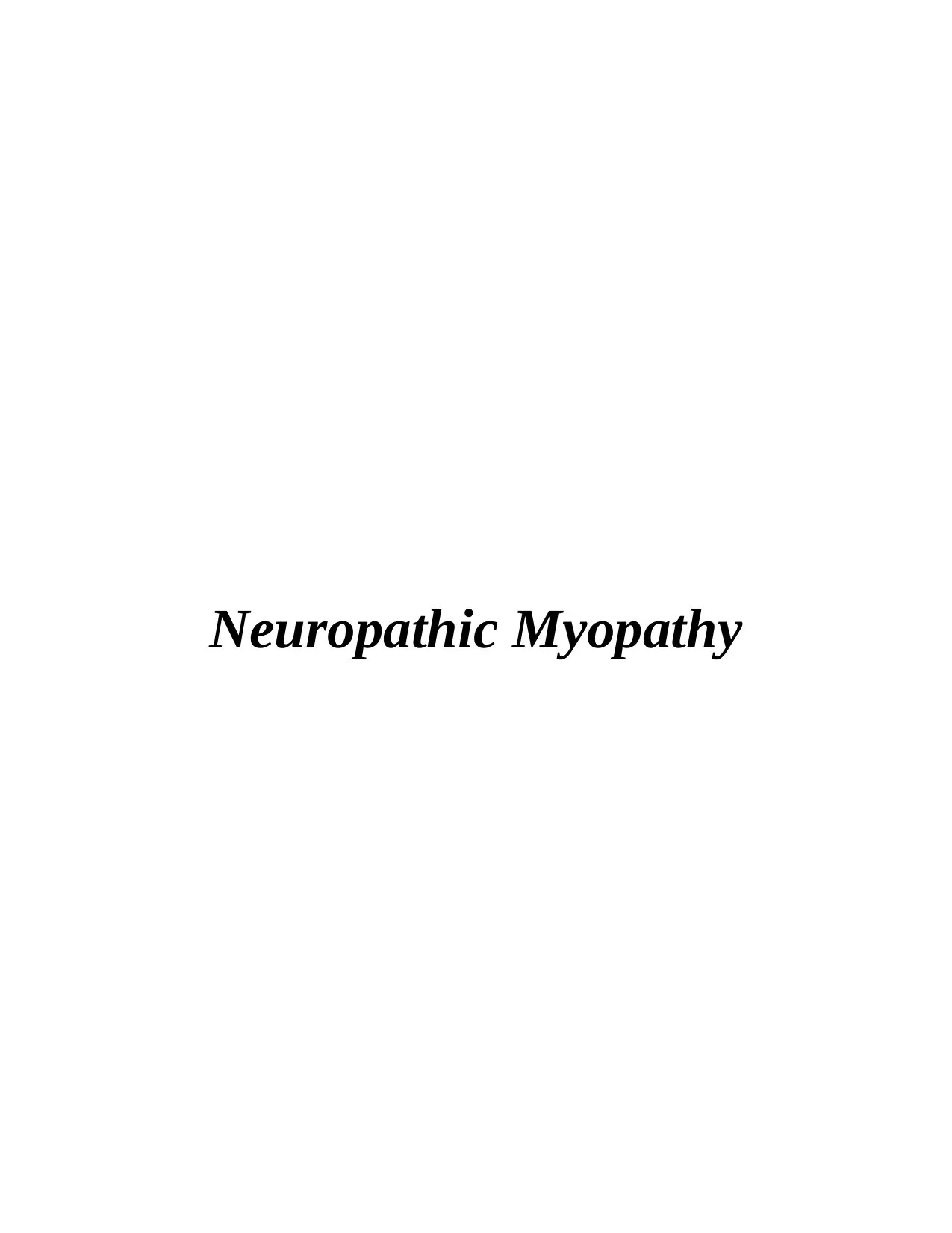
Neuropathic Myopathy
Paraphrase This Document
Need a fresh take? Get an instant paraphrase of this document with our AI Paraphraser
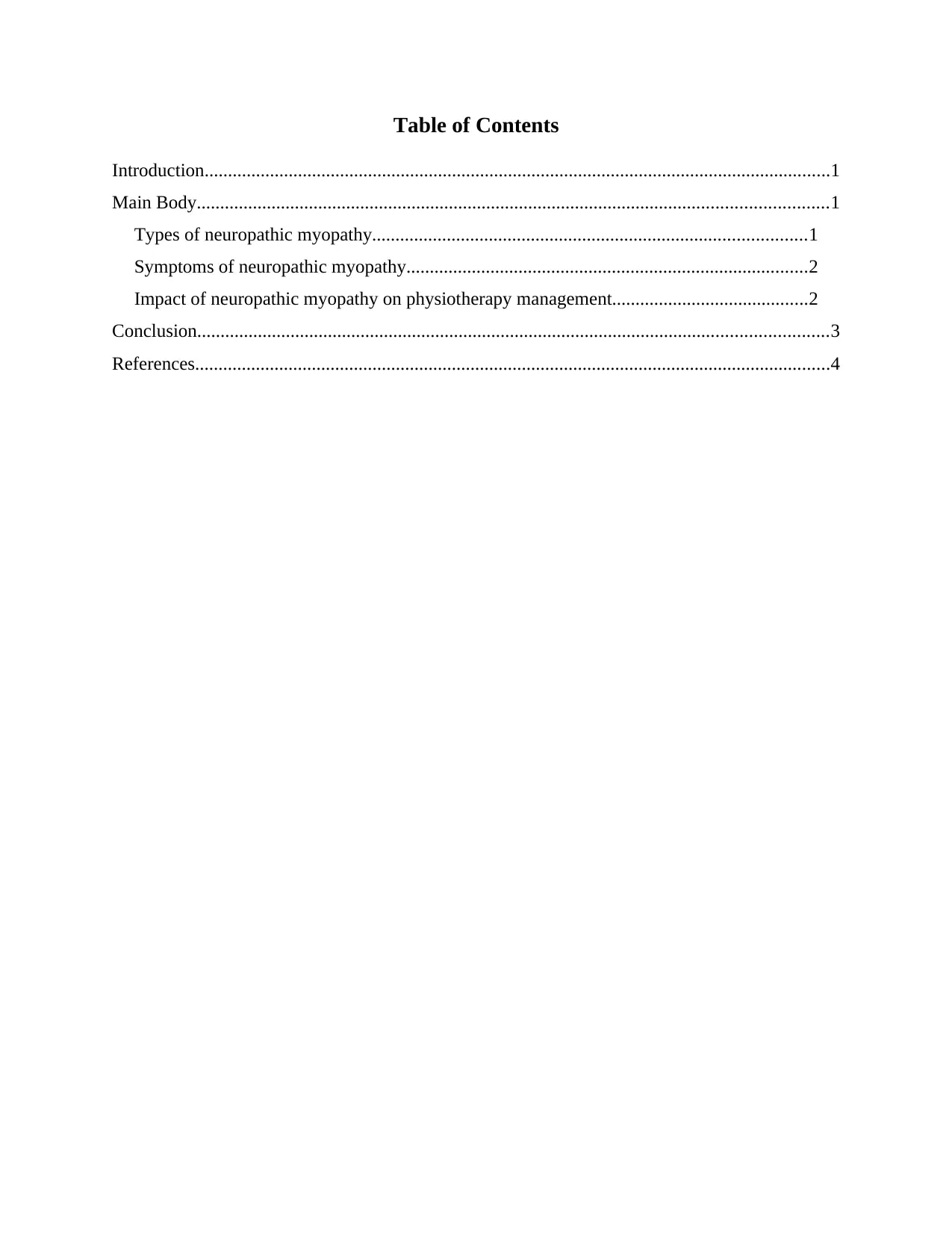
Table of Contents
Introduction......................................................................................................................................1
Main Body.......................................................................................................................................1
Types of neuropathic myopathy.............................................................................................1
Symptoms of neuropathic myopathy......................................................................................2
Impact of neuropathic myopathy on physiotherapy management..........................................2
Conclusion.......................................................................................................................................3
References........................................................................................................................................4
Introduction......................................................................................................................................1
Main Body.......................................................................................................................................1
Types of neuropathic myopathy.............................................................................................1
Symptoms of neuropathic myopathy......................................................................................2
Impact of neuropathic myopathy on physiotherapy management..........................................2
Conclusion.......................................................................................................................................3
References........................................................................................................................................4

⊘ This is a preview!⊘
Do you want full access?
Subscribe today to unlock all pages.

Trusted by 1+ million students worldwide
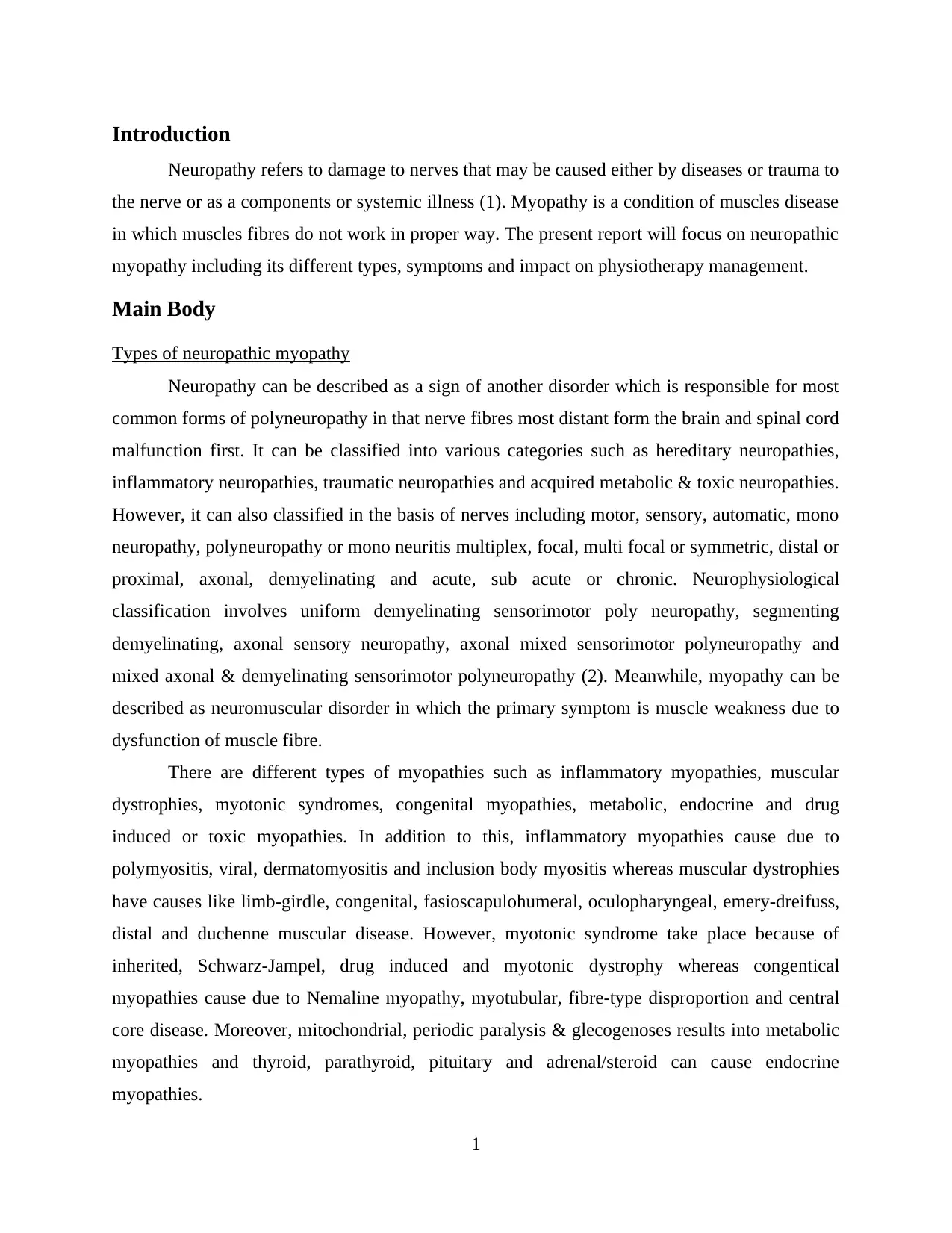
Introduction
Neuropathy refers to damage to nerves that may be caused either by diseases or trauma to
the nerve or as a components or systemic illness (1). Myopathy is a condition of muscles disease
in which muscles fibres do not work in proper way. The present report will focus on neuropathic
myopathy including its different types, symptoms and impact on physiotherapy management.
Main Body
Types of neuropathic myopathy
Neuropathy can be described as a sign of another disorder which is responsible for most
common forms of polyneuropathy in that nerve fibres most distant form the brain and spinal cord
malfunction first. It can be classified into various categories such as hereditary neuropathies,
inflammatory neuropathies, traumatic neuropathies and acquired metabolic & toxic neuropathies.
However, it can also classified in the basis of nerves including motor, sensory, automatic, mono
neuropathy, polyneuropathy or mono neuritis multiplex, focal, multi focal or symmetric, distal or
proximal, axonal, demyelinating and acute, sub acute or chronic. Neurophysiological
classification involves uniform demyelinating sensorimotor poly neuropathy, segmenting
demyelinating, axonal sensory neuropathy, axonal mixed sensorimotor polyneuropathy and
mixed axonal & demyelinating sensorimotor polyneuropathy (2). Meanwhile, myopathy can be
described as neuromuscular disorder in which the primary symptom is muscle weakness due to
dysfunction of muscle fibre.
There are different types of myopathies such as inflammatory myopathies, muscular
dystrophies, myotonic syndromes, congenital myopathies, metabolic, endocrine and drug
induced or toxic myopathies. In addition to this, inflammatory myopathies cause due to
polymyositis, viral, dermatomyositis and inclusion body myositis whereas muscular dystrophies
have causes like limb-girdle, congenital, fasioscapulohumeral, oculopharyngeal, emery-dreifuss,
distal and duchenne muscular disease. However, myotonic syndrome take place because of
inherited, Schwarz-Jampel, drug induced and myotonic dystrophy whereas congentical
myopathies cause due to Nemaline myopathy, myotubular, fibre-type disproportion and central
core disease. Moreover, mitochondrial, periodic paralysis & glecogenoses results into metabolic
myopathies and thyroid, parathyroid, pituitary and adrenal/steroid can cause endocrine
myopathies.
1
Neuropathy refers to damage to nerves that may be caused either by diseases or trauma to
the nerve or as a components or systemic illness (1). Myopathy is a condition of muscles disease
in which muscles fibres do not work in proper way. The present report will focus on neuropathic
myopathy including its different types, symptoms and impact on physiotherapy management.
Main Body
Types of neuropathic myopathy
Neuropathy can be described as a sign of another disorder which is responsible for most
common forms of polyneuropathy in that nerve fibres most distant form the brain and spinal cord
malfunction first. It can be classified into various categories such as hereditary neuropathies,
inflammatory neuropathies, traumatic neuropathies and acquired metabolic & toxic neuropathies.
However, it can also classified in the basis of nerves including motor, sensory, automatic, mono
neuropathy, polyneuropathy or mono neuritis multiplex, focal, multi focal or symmetric, distal or
proximal, axonal, demyelinating and acute, sub acute or chronic. Neurophysiological
classification involves uniform demyelinating sensorimotor poly neuropathy, segmenting
demyelinating, axonal sensory neuropathy, axonal mixed sensorimotor polyneuropathy and
mixed axonal & demyelinating sensorimotor polyneuropathy (2). Meanwhile, myopathy can be
described as neuromuscular disorder in which the primary symptom is muscle weakness due to
dysfunction of muscle fibre.
There are different types of myopathies such as inflammatory myopathies, muscular
dystrophies, myotonic syndromes, congenital myopathies, metabolic, endocrine and drug
induced or toxic myopathies. In addition to this, inflammatory myopathies cause due to
polymyositis, viral, dermatomyositis and inclusion body myositis whereas muscular dystrophies
have causes like limb-girdle, congenital, fasioscapulohumeral, oculopharyngeal, emery-dreifuss,
distal and duchenne muscular disease. However, myotonic syndrome take place because of
inherited, Schwarz-Jampel, drug induced and myotonic dystrophy whereas congentical
myopathies cause due to Nemaline myopathy, myotubular, fibre-type disproportion and central
core disease. Moreover, mitochondrial, periodic paralysis & glecogenoses results into metabolic
myopathies and thyroid, parathyroid, pituitary and adrenal/steroid can cause endocrine
myopathies.
1
Paraphrase This Document
Need a fresh take? Get an instant paraphrase of this document with our AI Paraphraser
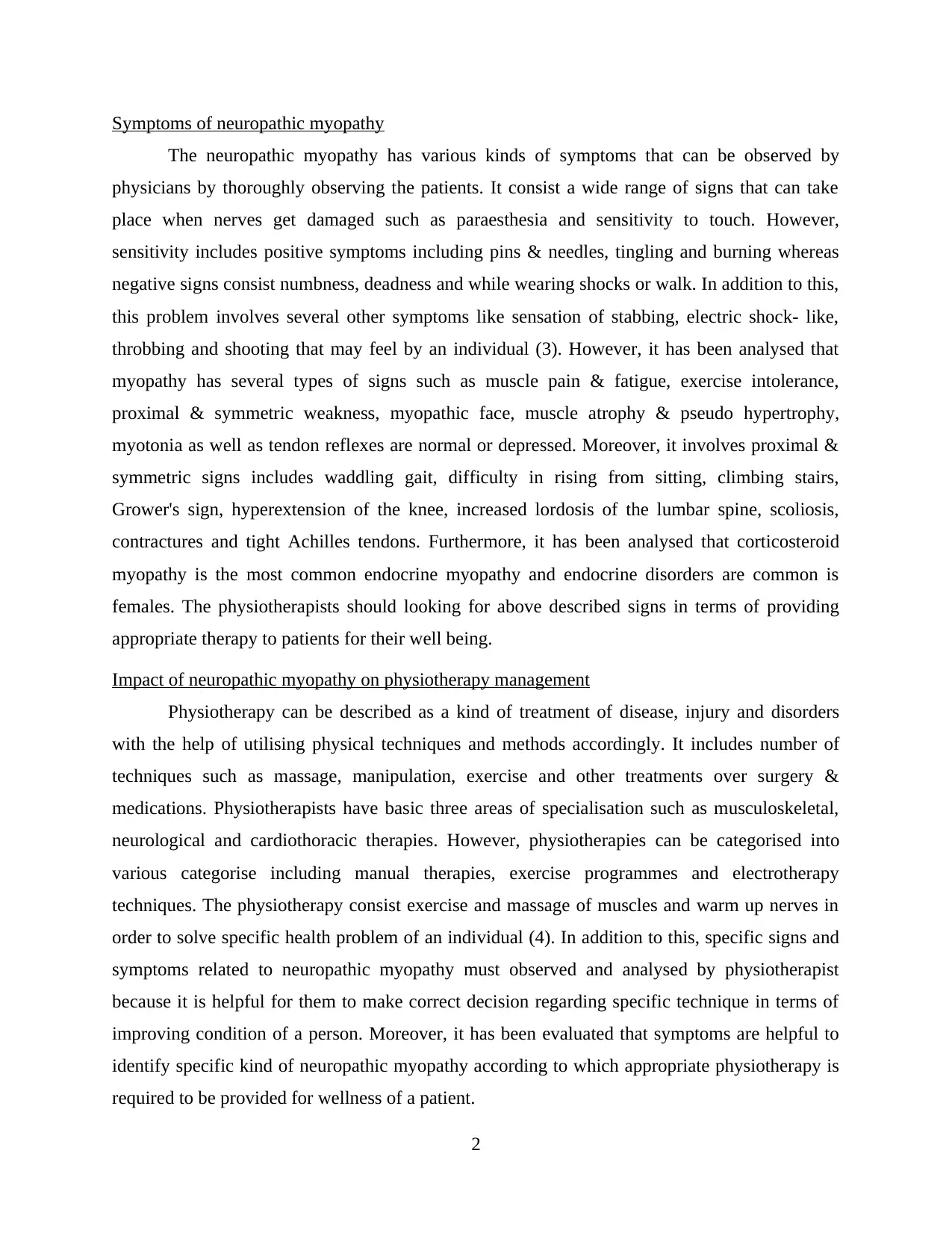
Symptoms of neuropathic myopathy
The neuropathic myopathy has various kinds of symptoms that can be observed by
physicians by thoroughly observing the patients. It consist a wide range of signs that can take
place when nerves get damaged such as paraesthesia and sensitivity to touch. However,
sensitivity includes positive symptoms including pins & needles, tingling and burning whereas
negative signs consist numbness, deadness and while wearing shocks or walk. In addition to this,
this problem involves several other symptoms like sensation of stabbing, electric shock- like,
throbbing and shooting that may feel by an individual (3). However, it has been analysed that
myopathy has several types of signs such as muscle pain & fatigue, exercise intolerance,
proximal & symmetric weakness, myopathic face, muscle atrophy & pseudo hypertrophy,
myotonia as well as tendon reflexes are normal or depressed. Moreover, it involves proximal &
symmetric signs includes waddling gait, difficulty in rising from sitting, climbing stairs,
Grower's sign, hyperextension of the knee, increased lordosis of the lumbar spine, scoliosis,
contractures and tight Achilles tendons. Furthermore, it has been analysed that corticosteroid
myopathy is the most common endocrine myopathy and endocrine disorders are common is
females. The physiotherapists should looking for above described signs in terms of providing
appropriate therapy to patients for their well being.
Impact of neuropathic myopathy on physiotherapy management
Physiotherapy can be described as a kind of treatment of disease, injury and disorders
with the help of utilising physical techniques and methods accordingly. It includes number of
techniques such as massage, manipulation, exercise and other treatments over surgery &
medications. Physiotherapists have basic three areas of specialisation such as musculoskeletal,
neurological and cardiothoracic therapies. However, physiotherapies can be categorised into
various categorise including manual therapies, exercise programmes and electrotherapy
techniques. The physiotherapy consist exercise and massage of muscles and warm up nerves in
order to solve specific health problem of an individual (4). In addition to this, specific signs and
symptoms related to neuropathic myopathy must observed and analysed by physiotherapist
because it is helpful for them to make correct decision regarding specific technique in terms of
improving condition of a person. Moreover, it has been evaluated that symptoms are helpful to
identify specific kind of neuropathic myopathy according to which appropriate physiotherapy is
required to be provided for wellness of a patient.
2
The neuropathic myopathy has various kinds of symptoms that can be observed by
physicians by thoroughly observing the patients. It consist a wide range of signs that can take
place when nerves get damaged such as paraesthesia and sensitivity to touch. However,
sensitivity includes positive symptoms including pins & needles, tingling and burning whereas
negative signs consist numbness, deadness and while wearing shocks or walk. In addition to this,
this problem involves several other symptoms like sensation of stabbing, electric shock- like,
throbbing and shooting that may feel by an individual (3). However, it has been analysed that
myopathy has several types of signs such as muscle pain & fatigue, exercise intolerance,
proximal & symmetric weakness, myopathic face, muscle atrophy & pseudo hypertrophy,
myotonia as well as tendon reflexes are normal or depressed. Moreover, it involves proximal &
symmetric signs includes waddling gait, difficulty in rising from sitting, climbing stairs,
Grower's sign, hyperextension of the knee, increased lordosis of the lumbar spine, scoliosis,
contractures and tight Achilles tendons. Furthermore, it has been analysed that corticosteroid
myopathy is the most common endocrine myopathy and endocrine disorders are common is
females. The physiotherapists should looking for above described signs in terms of providing
appropriate therapy to patients for their well being.
Impact of neuropathic myopathy on physiotherapy management
Physiotherapy can be described as a kind of treatment of disease, injury and disorders
with the help of utilising physical techniques and methods accordingly. It includes number of
techniques such as massage, manipulation, exercise and other treatments over surgery &
medications. Physiotherapists have basic three areas of specialisation such as musculoskeletal,
neurological and cardiothoracic therapies. However, physiotherapies can be categorised into
various categorise including manual therapies, exercise programmes and electrotherapy
techniques. The physiotherapy consist exercise and massage of muscles and warm up nerves in
order to solve specific health problem of an individual (4). In addition to this, specific signs and
symptoms related to neuropathic myopathy must observed and analysed by physiotherapist
because it is helpful for them to make correct decision regarding specific technique in terms of
improving condition of a person. Moreover, it has been evaluated that symptoms are helpful to
identify specific kind of neuropathic myopathy according to which appropriate physiotherapy is
required to be provided for wellness of a patient.
2
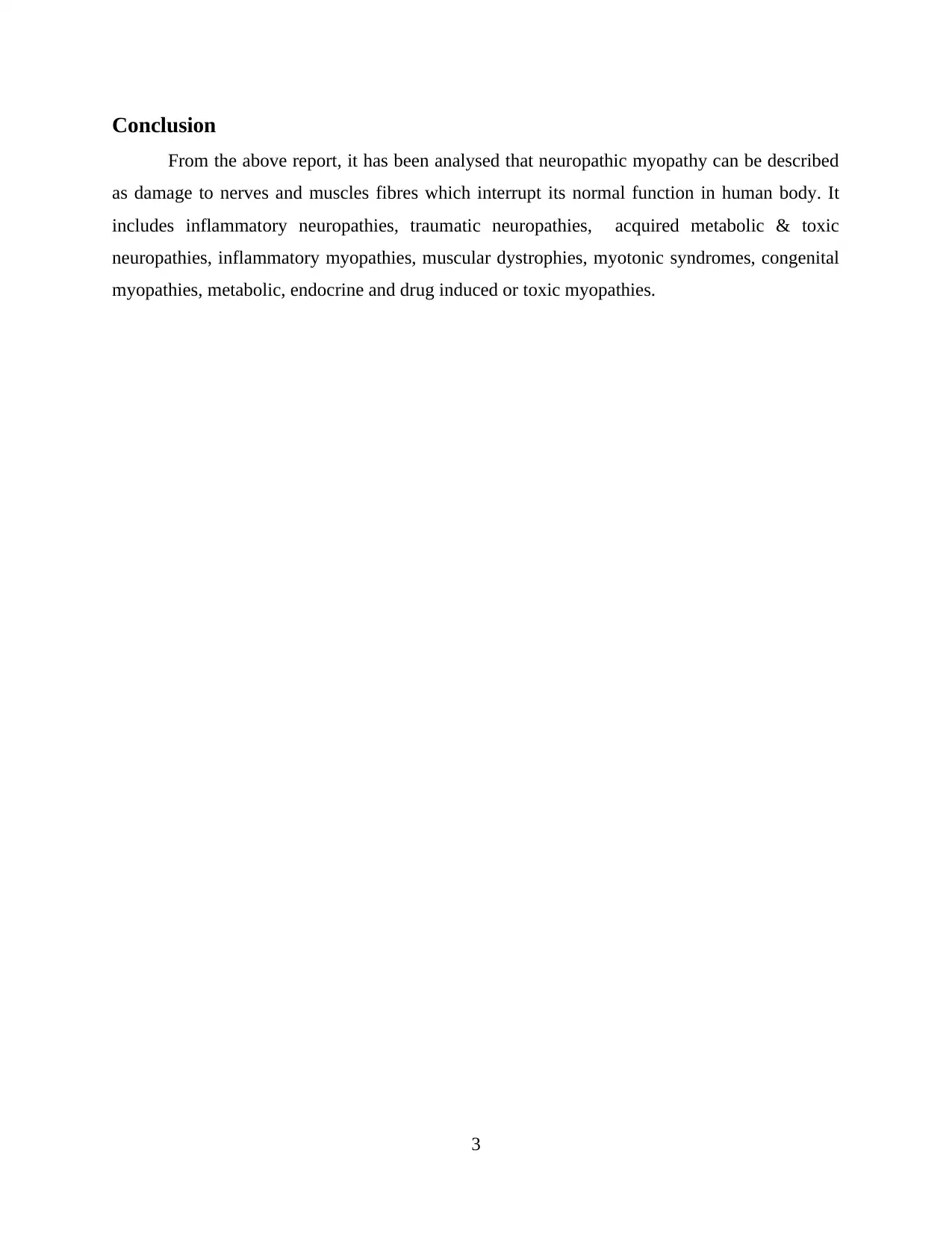
Conclusion
From the above report, it has been analysed that neuropathic myopathy can be described
as damage to nerves and muscles fibres which interrupt its normal function in human body. It
includes inflammatory neuropathies, traumatic neuropathies, acquired metabolic & toxic
neuropathies, inflammatory myopathies, muscular dystrophies, myotonic syndromes, congenital
myopathies, metabolic, endocrine and drug induced or toxic myopathies.
3
From the above report, it has been analysed that neuropathic myopathy can be described
as damage to nerves and muscles fibres which interrupt its normal function in human body. It
includes inflammatory neuropathies, traumatic neuropathies, acquired metabolic & toxic
neuropathies, inflammatory myopathies, muscular dystrophies, myotonic syndromes, congenital
myopathies, metabolic, endocrine and drug induced or toxic myopathies.
3
⊘ This is a preview!⊘
Do you want full access?
Subscribe today to unlock all pages.

Trusted by 1+ million students worldwide
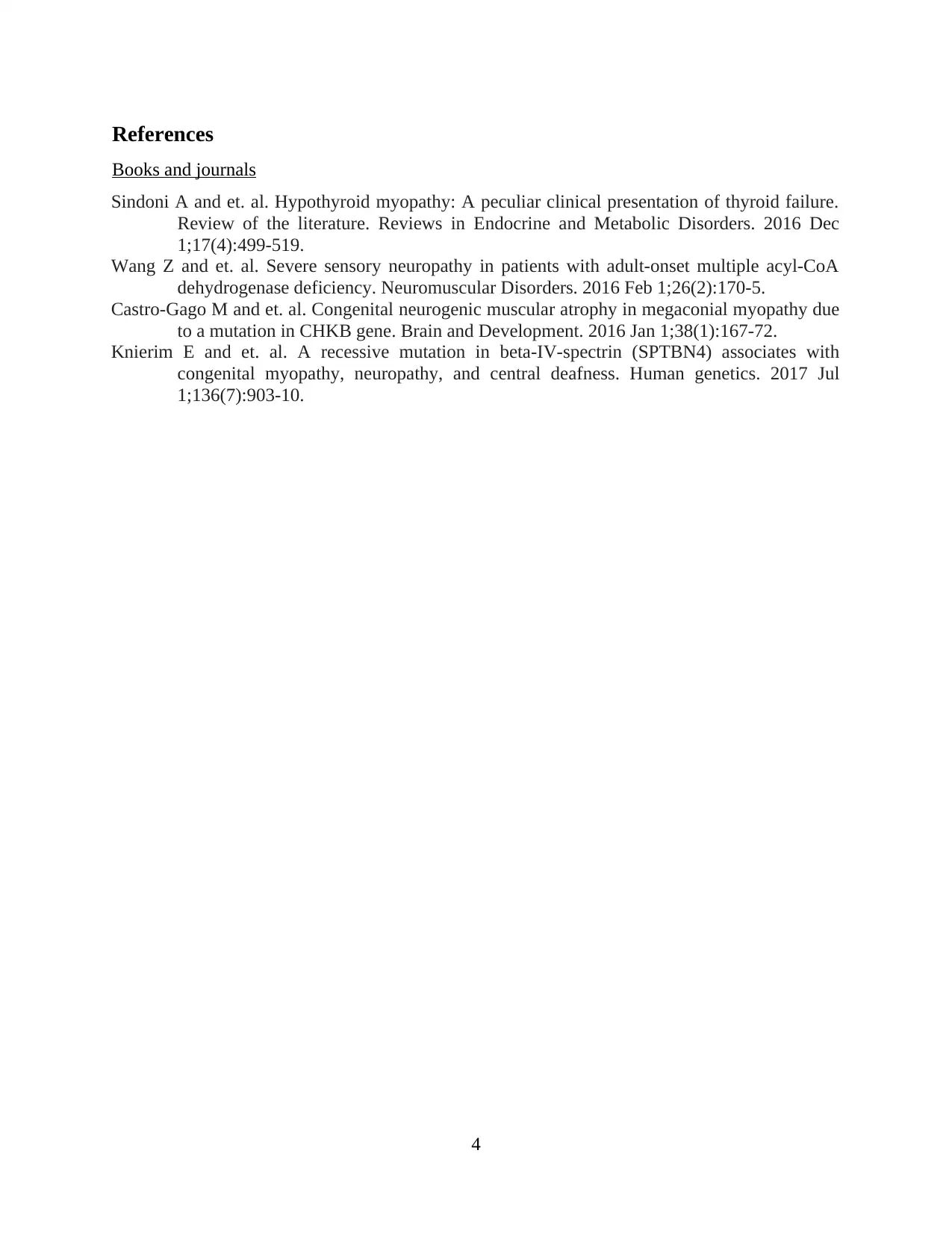
References
Books and journals
Sindoni A and et. al. Hypothyroid myopathy: A peculiar clinical presentation of thyroid failure.
Review of the literature. Reviews in Endocrine and Metabolic Disorders. 2016 Dec
1;17(4):499-519.
Wang Z and et. al. Severe sensory neuropathy in patients with adult-onset multiple acyl-CoA
dehydrogenase deficiency. Neuromuscular Disorders. 2016 Feb 1;26(2):170-5.
Castro-Gago M and et. al. Congenital neurogenic muscular atrophy in megaconial myopathy due
to a mutation in CHKB gene. Brain and Development. 2016 Jan 1;38(1):167-72.
Knierim E and et. al. A recessive mutation in beta-IV-spectrin (SPTBN4) associates with
congenital myopathy, neuropathy, and central deafness. Human genetics. 2017 Jul
1;136(7):903-10.
4
Books and journals
Sindoni A and et. al. Hypothyroid myopathy: A peculiar clinical presentation of thyroid failure.
Review of the literature. Reviews in Endocrine and Metabolic Disorders. 2016 Dec
1;17(4):499-519.
Wang Z and et. al. Severe sensory neuropathy in patients with adult-onset multiple acyl-CoA
dehydrogenase deficiency. Neuromuscular Disorders. 2016 Feb 1;26(2):170-5.
Castro-Gago M and et. al. Congenital neurogenic muscular atrophy in megaconial myopathy due
to a mutation in CHKB gene. Brain and Development. 2016 Jan 1;38(1):167-72.
Knierim E and et. al. A recessive mutation in beta-IV-spectrin (SPTBN4) associates with
congenital myopathy, neuropathy, and central deafness. Human genetics. 2017 Jul
1;136(7):903-10.
4
1 out of 7
Your All-in-One AI-Powered Toolkit for Academic Success.
+13062052269
info@desklib.com
Available 24*7 on WhatsApp / Email
![[object Object]](/_next/static/media/star-bottom.7253800d.svg)
Unlock your academic potential
Copyright © 2020–2025 A2Z Services. All Rights Reserved. Developed and managed by ZUCOL.